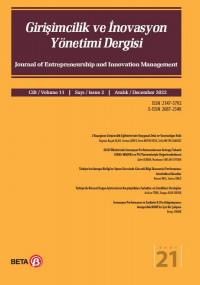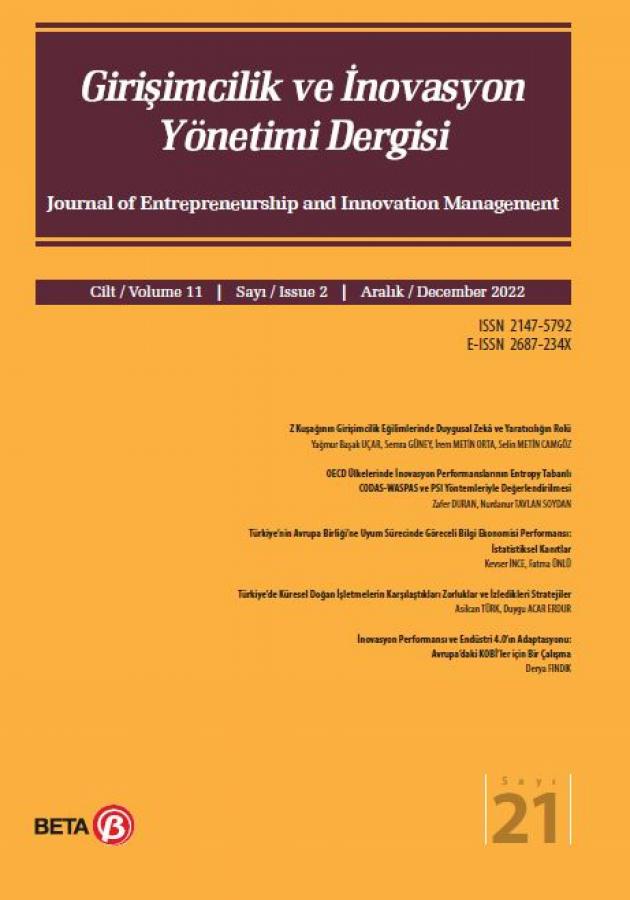9 (2), 2020
Cevahir Uzkurt
From The Editor
Cevahir Uzkurt
Journal Cover
Uğur Edeş & Eyüp Çalık
Scale Development for Measurement of Sustainable Process Innovation Performance of Manufacturing EnterprisesPurpose: In this study, it is aimed a scale development to measure sustainable process innovation performance of manufacturing enterprises.
Methodology: In the 17 item measurement model created based on the literature, explanatory factor analysis and confirmatory factor analysis were conducted by using a total of 291 valid data obtained from the manufacturing enterprises with the survey method.
Findings: As a result of the analyzes, a measurement model consisting of 15 items has emerged in order to help manufacturing enterprises to measure sustainable process innovation performance.
Practical Implications: The 15-item measurement scale obtained was introduced to using of manufacturing enterprises and investigators who will conduct research in sustainable innovation field.
Originality: In the literature, there is no scale development study previously conducted to measure sustainable process innovation performance in manufacturing enterprises. Hence, it is tried to fill the gap in this area by proposing this study.
Keywords: Sustainable Process Innovation, Scale Development, Measurement Model, EFA,CFA
[PDF]
An Empirical Analysis of Innovation Performance Measurement on Level 2 of the Regions in TurkeyABSTRACT
Purpose: In this study, we aimed to expose the innovative capacity of regional innovation systems within the framework of Turkey NUTS-2 regions.
Methodology: A large data set including 7 main components, 17 subcomponents and 58 indicators in total, which constitute the innovation input and output components for 2014-2018, has been prepared. The data obtained were analyzed by normalization method. As a result of the analysis, the overall innovation index score value and the index values of the innovation efficiency were calculated.
Findings: The findings provide an opportunity to evaluate and compare the innovation capacity of the regions. As a result of the general innovation index calculation, the region with the highest score is TR10, while the lowest region is TRA2. In the event score value, TR31 region has the highest score and TRC3 region has the lowest score value.
Practical Implications: Index calculations provide predictions in designing innovation policies to many actors and policy makers who also play an active role in regions. Innovation is more important to increase the efforts to improve the indicators of the input and output components, or to use them more effectively.
Originality: In the study, a comprehensive data set has been prepared in the innovation performance measurement indicators of NUTS2 regions and it is up-to-date as the latest available year data is used in all indicators.
Keywords: Regional Innovation, Innovation Performance, Normalization Method, Innovation Index.
[PDF]
New Generation Retailing: COVID-19 Process from Market to Home Service Innovation ResearchPurpose: In extraordinary situations, the importance of the companies that serve the concept from the market to home, which is one of the new generation e-retailing innovations, the reasons for consumer preference and their usage levels will be investigated.
Methodology: The first official corona virus in Turkey between the date when the case of a survey with 1000 figures the number of cases of the date of diagnosis was performed. Analyzes were made regarding the ages, income levels and gender of the people who received this service. A scale was developed for the reasons for using the service and regression analysis was carried out to find the relationship between the factors obtained.
Findings: A differentiation has been determined regarding the ages, income status and gender of the individuals. According to the Exploratory Factor Analysis; Three main factors have been identified: psychological, trust and customer service.
Practical Implicaitons: Companies can keep their customers more active with different promotions and services belonging to each group in the light of the factors in the scale according to their age groups, gender and income status.
Originality: Although there are many studies on e-retailing, no studies on this subject have been conducted in exceptional cases. This is the first study on this service that emerged as a new generation service innovation.
Keywords: COVID-19, Service Innovation, E-Retailing, Scale Analysis
[PDF]
Co-Creation with Open Innovation: An Application for Customer EngagementPurpose: In this study, it was aimed to determine the factors affecting participation in the co-creation behavior of individuals who generate idea in the open innovation process.
Methodology: Online research with samples consisting of open innovation platform members operating in Turkey were carried out.
Findings: As a result of the analysis made with structural equation modeling, it was concluded that they displayed a positive attitude towards co-creation, and perceived behavioral domination and attitude were effective on intention.
Practical Implications: While perceived psychological and social benefits affect attitude positively, it is seen that financial risks and benefits do not have an effect on attitude
Originality: The research makes a unique contribution to the literature by addressing the variables that affect individuals' open innovation participation and the relationship between them.
Keywords: Open innovation, Innovation, Planned Behavior Theory, Co-creation
[PDF]
The Role of KOSGEB Supports on the Relationship between Coaching - Mentoring and Entrepreneurship IntentionPurpose: The closest candidates for initiating new businesses are novices and apprentices raised in the hands of craftsmen. Novices and apprentices receive one-on-one mentoring and coaching service from their masters during the training process. Various supports are provided by KOSGEB for the establishment of an entrepreneurial culture in society and for giving coaching and mentoring services to professionals. It is important that mentors and coaches inform novices and apprentices about these supports and encourage them to entrepreneurship.
Methodology: In this quantitative research, it was aimed to determine the effect of coaching and mentoring on entrepreneurial tendencies of novices and apprentices. 413 valid questionnaire feedbacks were obtained from novices and apprentices working in small enterprises by using easy access data collection method. Data analysis was performed using descriptive statistics, explanatoryfactoranalysis, structural equation modelling and process named moderating variable analysis technique.
Findings: According to there search findings, it was determined that coaching and mentoring had a positive and significant effect on entrepreneurial intent.
Pratical Implications: In there search, it was concluded that the coaches and mentors (masters) had great duties in the orientation of then ovices and apprentices to become entrepreneurs.
Orjinality: The absence of a study investigating the effects of coaching and mentoring support on entrepreneurship intent reveals the original value of the study.
Keywords: Entrepreneurial Intention, Coaching, Mentorship, KOSGEB Entrepreneurship Supports
[PDF]
Classification of the Relationship Between Social Intelligence and Personality Traits of EntrepreneursPurpose– This study aims to determine the probability of correctly classifying the dimensions of social intelligence as dependent variables by using personality traits of entrepreneurs as independent variables.
Methodology – The population of the research is the senior students who took the entrepreneurship course in the 2018-2019 academic year at Afyon Kocatepe University. The data of the research was obtained through Questionnaire.
Findings – While determining the entrepreneur profiles of 5 independent variables in the Personality Traits of Entrepreneurial scale, it is concluded that they can only be associated with the Empathy dependent variable. Practical Implications – The use of different classification techniques will contribute to the evaluation of the best model suggested within this study. The effects of psychological factors on respondents' responses should be investigated and the mediating role of psychological factors should be evaluated.
Originality- In this study, the relationship between social intelligence and personality traits of entrepreneurs was classified and it was clarified which social intelligence dimensions can be statistically associated with personality traits of entrepreneurs.
Keywords: Social Intelligence,Entrepreneurship,discriminant anaysis,Personality Traits
[PDF]
A New Solution Proposal to KOSGEB for the Project Evaluation SystemsPurpose: The aim of the study is to propose a competency-based evaluation system that uses IT infrastructure to address the increasing rate of KOSGEB support requests instead of the manual evaluation processes currently in place.
Methodology: According to opinions received from experts, the criteria are listed in the order of importance by the SWARA method.
Findings: For the KOSGEB criteria, risk assessment was given first priority ranking, and management and organizational plan was given last priority.
Conclusion and Suggestions: In the KOSGEB support assessment process, different methods of artificial intelligence and multi-criteria decision-making techniques can be combined to contribute to both the industry and the literature.
Original Value: It was determined that no method was used in our country for KOSGEB election evaluations.
Keywords: KOSGEB, SME, Multi Criteria Decision Making (MCDM),SWARA
[PDF]
Evaluation of Innovative and Entrepreneurial University Index Data Using ARAS-G Method in the Period of 2012-2017Purpose: To create an alternative single ranking based on the values of the universities included in the Innovative and Entrepreneurial University index between 2012-2017.
Methodology/Approach: In this study, the ARAS-G method is used in integration with the gray numbers. In order to examine the validity of the proposed model, in addition to the year-based rankings, the TOPSIS-G method also ranked the results and the correlations between these rankings are examined.
Findings: It is determined that the ranking found with the ARAS-G method has a significant high correlation with all years and this method represents more each year than the TOPSIS-G method. According to the results of the analysis made with the ARAS-G method, Sabancı University ranked first, and Middle East Technical University ranked second.
Practical implications: The proposed ARAS-G method produces valid results in this study in which the time period is also included in the decision process. In another decision problem, examining the applicability of the method can also be suggested to repeat the analysis by weighting by years for the mean and standard deviation calculated while obtaining gray numbers.
Originality: The integrated use of the gray numbers calculated to represent the specified time interval with the ARAS method constitutes the original value of the study.
Keywords: Innovative and Entrepreneurial Universities, Grey Numbers, ARAS-G, ARAS, Third Mission
[PDF]


